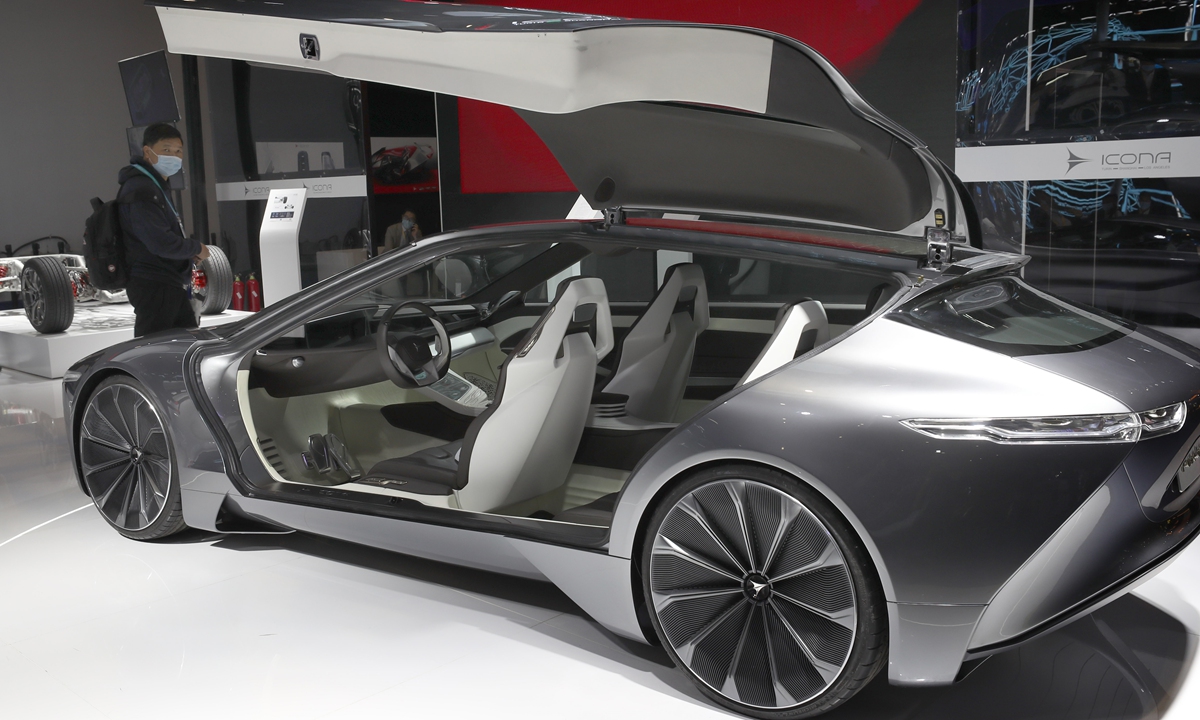China’s NEV sales forecast to grow by more than 30% in 2021: analysts
By Zhang Hongpei Source: Global Times Published: 2020/12/16 18:47:16
Sales forecast to hit more than 30% growth in 2021: analysts

A new energy vehicle at the 3rd China International Import Expo held in Shanghai in November Photo: cnsphoto
From the small but functional Wuling Hongguang MINI electric vehicle (EV) priced at less than 30,000-yuan ($4,578) to the high-end Model 3 sedan by US tech giant Tesla priced at under 300,000-yuan, green vehicles have become a growing trend in the world's second largest economy and the largest newenergy vehicle (NEV) market.
The Chinese NEV industry including EVs, plug-in hybrid vehicles and fuel cell vehicles is being embraced with unprecedented enthusiasm as more market-driven products are unveiled and consumptions continue upward.
Betting on a bright outlook, industry analysts forecast that the growth of China's NEV sales will jump by more than 30 percent in 2021 and that brands will have to compete to win consumers.
Latest data from the National Bureau of Statistics showed on Tuesday that China's NEV output in November reached 207,000 units, up 99 percent year-on-year.
Data from the China Association of Automobile Manufacturers (CAAM) showed that NEV sales rose for a fifth straight month surpassing 200,000 units, an increase of 104.9 percent year-on-year.
The Hongguang MINI EV, produced by the SAIC-GM-Wuling joint venture, has become the most popular EV model in China in the past few months, overtaking the No.1 position long held by Tesla's Model 3.
In November, 33,094 units of Hongguang Mini EV were sold compared with 21,604 units of Model 3. Shenzhen-based BYD secured the second spot by total sales of 26,015 units. The top three automakers took up nearly half stake of domestic NEV sales.
Cui Dongshu, the Secretary General of the China Passenger Car Association, told the Global Times that China's NEV market has seen scaling up based on the sales number of the top market players.
"New driving forces for domestic EV development have emerged this year. The crucial factor is reducing costs to meet more consumer demand," Cui said.
The COVID-19 epidemic dragged down the domestic auto sector in the first half of the year, however, disruptions have gradually ebbed in the second half as reflected by positive growth of both production and sales.
Yale Zhang, head of Shanghai-based consultancy Automotive Foresight, believed there will be "explosive growth" in the domestic NEV market next year. He forecast an increase of 30-40 percent growth rate in sales on a yearly basis.
"More market-driven products will be unveiled by automakers next year as they are all vying for a piece of China's burgeoning NEV sector," Zhang told the Global Times on Tuesday.
The other favorable factor is that as automakers focus on controlling costs, prices are likely to fall to meet greater consumer demand, according to Zhang.
Ye Shengji, the vice general-secretary of the CAAM, estimated that Chinese NEV market is likely to surprise the world with over 30 percent growth in 2021 with sales hitting 1.8 million units.
China recorded 1.2 million NEV sales in 2019, a decrease of 4 percent year-on-year.
As this year is drawing near the end, analysts forecast single-digit growth in 2020 based on the figure of the first 11 months.
According Yu Qingjiao, secretary general of the Zhongguancun New Battery Technology Innovation Alliance, NEV sales in December could surpass 200,000 units, adding to an annual total of around 1.3 million units.
China has been implementing its promise to tackle climate change and pushing forward the green cars over recent years, and it is an irreversible trend, Yu told the Global Times.
The State Council, China's cabinet, said in a plan released in November which demonstrated the nation's ambition shifting from a major automobile country to a major power, as sales of NEVs in China are forecast to rise to 20 percent of overall new car sales by 2025 from only 5 percent at the moment.
Reassuring supply chain
With effective virus prevention measures in place, the Chinese economy became the first to emerge from the virus-tangled mire and it is likely to be the only economy in the world to register positive growth this year, according to an IMF forecast.
Rapid resumption of a highly developed supply chain has not only boosted the nation's own auto industry but cemented recovery of global automakers, which have been grappling with weak sales in overseas markets where coronavirus infections have been surging again.
US automaker Ford and its Chinese joint venture 164,352 vehicles in the Chinese market in the third quarter, up 25.4 percent year-over-year, the largest since fourth quarter 2016, according to a statement Ford sent to the Global Times.
Another US automaker General Motors (GM) and its joint venture entities delivered more than 771,400 vehicles in China over the third quarter, an increase of 12 percent year-on-year.
According to GM China President Julian Blissett, the company has basically realized supply chain localization for the Chinese market.
"The pandemic outbreak had suspended operation of our suppliers in the US, Mexico and Brazil at the early stage, but it has no impact on the production in China," he said.
GM has launched more than 10 NEV models in China including the popular Wuling Hongguang MINI EV. In the next five years, more than 40 percent of GM's new launches in China will be NEVs, the company said.
William Li Bin, the Chief Executive of Chinese EV maker NIO, told a recent forum that the competitiveness of China's current automotive supply chain is very strong in respect to both volume and scale.
"Car brands around the world are basically all looking for supply chains in China, including Tesla, Toyota and Volkswagen," said Li.
He added that China's auto industrial capacity has profoundly affected the entire global auto industry.
Newspaper headline: NEV charging ahead
RELATED ARTICLES:
Posted in: INDUSTRIES